It rained! After nearly three weeks with nary a drop, we've finally had some significant rains recently. Not what we really need, unfortunately, but enough to lend a little help to the regular watering schedule. Rain plus heat means that things are moving along quickly. Flowers, including cosmos, bachelor's buttons, snapdragons, nasturtiums, love-in-a-mist, marigolds, and, uh, broccoli raab, are in bloom:
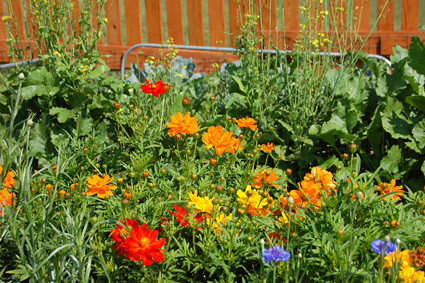
The peppers are big, bushy, and fruiting:
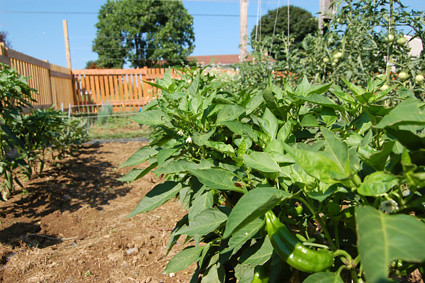
Most are from saved seed, and since peppers are more prone to cross-pollination than tomatoes, beans, or some of the others I'm also trying, it's interesting to see what's happening. The jalapenos, for example, are shaped a bit different, and the ones I picked earlier today are fruitier in taste, and less grassy, than those from last year. Near the same heat level, though.
The watermelon may or may not be from saved seeds. I didn't trust the saved seeds, so planted some that were left over from last year, but just about everything came up. And they're loving the heat so far:
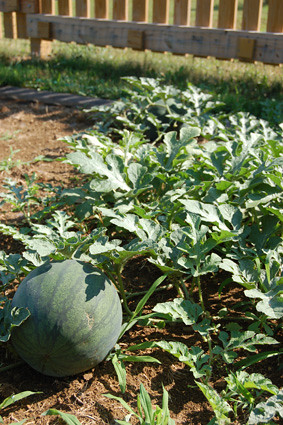
Among the other so-far successes: giant, vigorous buckwheat in flower; sweet carrots big enough to eat as I thin the row; new potatoes; big pole beans flowering like mad. And tomatoes taller than me:
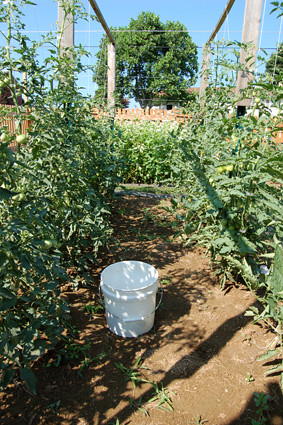
The trellis is more than six feet high, and the Sun Golds are just about there.
The main reason they're so tall is that I'm carefully pruning indeterminate tomatoes.1 With big, long vines, they need support - mason twine and greenhouse clips, in my case, hanging from a wooden bar - and benefit from pruning off unnecessary suckers. Like these:
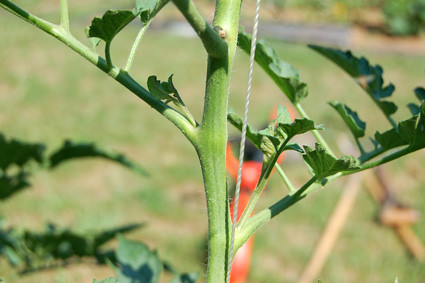
See those little stems growing out between the main stalk and the leaf branches? They're called suckers, and represent a new growth point and vine that'll produce more leaves, more flowers, and more fruit. If I lived in a tropical paradise, with all the time in the world to let these grow, that'd be no problem. But the extra energy necessary to grow them means that they'll slow down fruit production, and give smaller tomatoes. One plant can only do so much.
Pinch or snip them off, and the plant will devote more of its energy to the existing growth points:
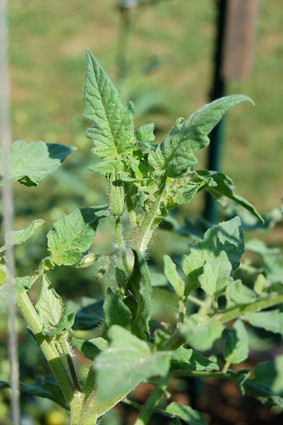
It's a tangle of hard-to-see and harder-to-photograph little plant parts, but careful inspection reveals tiny developing leaves, flower buds, and more continually unfurling. It's the heart of the plant's growth, and damaging it means you're limited to what's already below it. Generally speaking, you want to be extra cautious to avoid damage, though clipping the top at the end of the season can force any unripe fruit to ripen more quickly.
For the most part, it's straightforward. Pinch the unwanted suckers. Leave only the ones you intend to keep and train up. I keep one sucker per plant, and plant them with enough space so as to avoid crowding. Every so often, there's one that I've missed, that's just too large to remove, so I'll train that one, as well.
Be aware that there's a pinching procedure. Tiny suckers can simply be pinched off with fingertips, though doing so too close to the main growth point is asking for trouble, especially if you've misidentified what you're supposed to remove. (It happens.) Larger suckers can be broken off, but it's a two-step snap. Bend it left, until you hear the stem break, then bend it the other way to break it off completely. Just going in one direction runs the risk of stripping a swath of the stem's outer layer away, opening up the plant to infection.
Too big, and you need shears or another support.
Ideally, these are the scars you'll see:
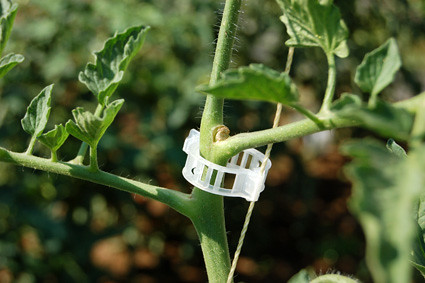
Here you can see two different-sized scars, likely each pinched off at the same time. One was tiny, the other a bit larger. The smaller ones, I find, are more likely to give you this:
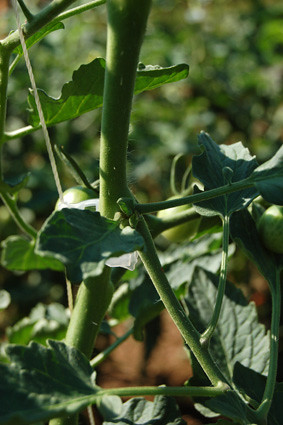
Sometimes, a sucker grows back from where it had been pinched off. So you need to check again, lest you miss a new, two-foot tomato plant bursting forth. Relatively easy, right?
If you're growing hybrids, sure. My Sun Golds are clockwork-level predictable. But I can't save seed from them, and there are a number of heirlooms that I really like growing and eating. The problem with heirlooms, though, is that they're less predictable. Whereas a hybrid almost always sends forth suckers from between the leaves and the stalk, with leaves branching out on one side, then later the other, heirlooms sometimes give you this:
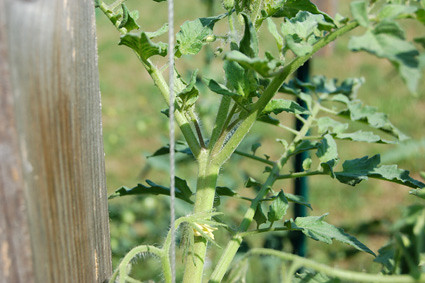
Leaves twinned off at the same point. Sometimes no big deal. Sometimes, those two suckers are the only remaining growth point, and what had been the growth point is now just a flower cluster. Pinch off those suckers, and that's all the plant you've got.2
The other, just as vexing problem is this:

It's a sucker. Growing from the end of a fruit cluster.
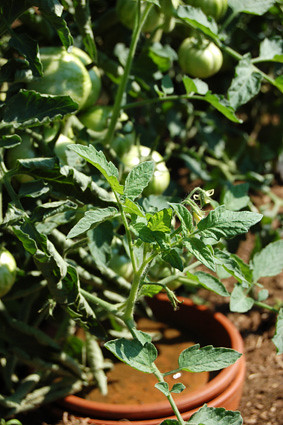
Not at all where you'll hear about suckers forming, but heirlooms do it all the time. Thus far, I've found them on Black Plums, Wapsipinicon Peaches, Green Zebras (pictured), and Jaune Flammes. I've yet to find them elsewhere, but won't be surprised when I do.
* * * * *
1I have one determinate variety this year, as an experiment. We'll see how it goes.
2My Black Plums insist on doing this. I don't know why, but I have to watch them very carefully because of it. If they weren't such fine tomatoes, I might be bothered.

1 comment:
hey Brian,
thanks for the tutorial on suckers. I pinched a few off of my tomatoes this past week. Maybe someday I should post some pics of my garden for you to see... it is of course, an amature, first-year-gardener's garden, but i'm getting kind of addicted to watching things pop out of the ground!
Post a Comment